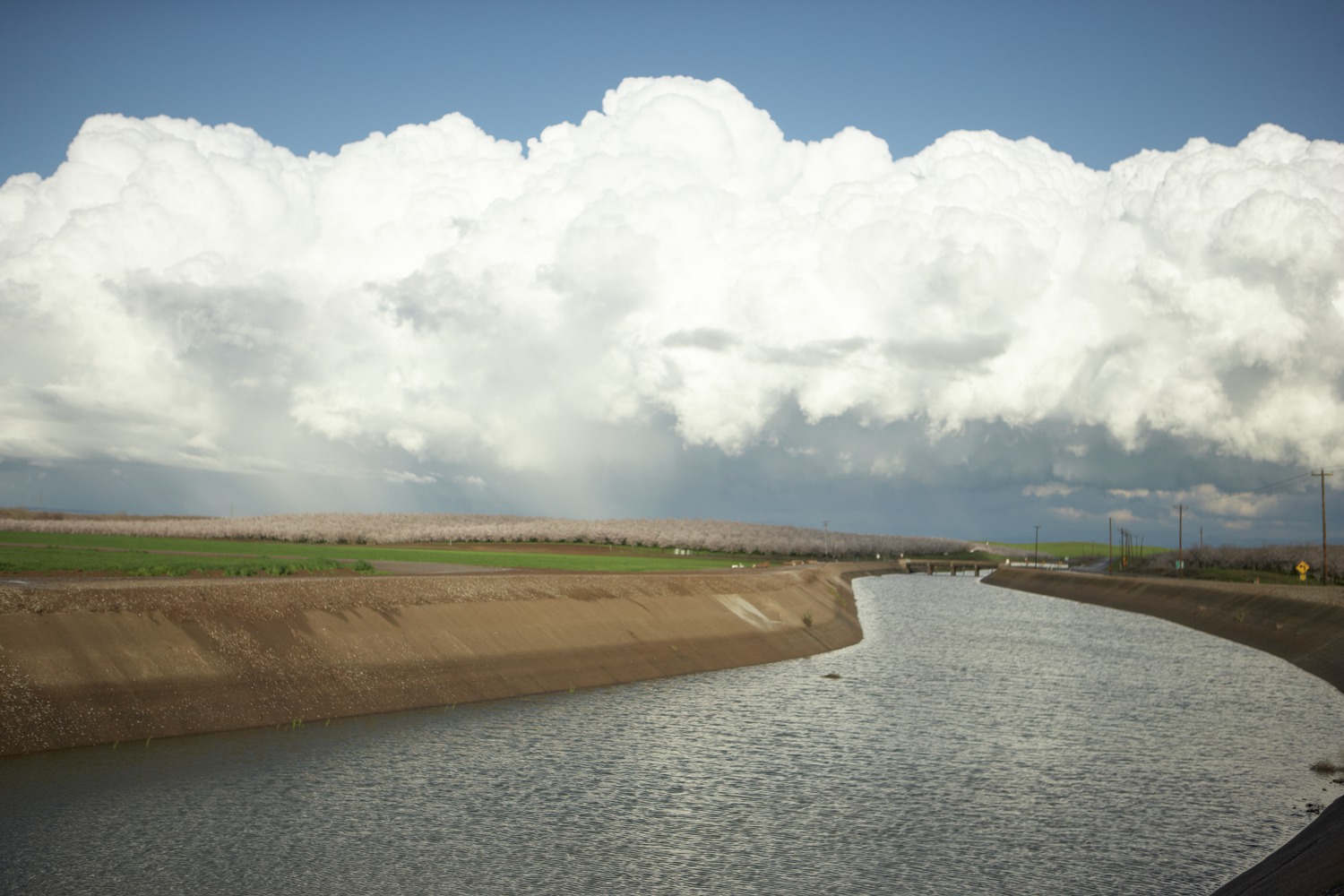
After decades of over-pumping groundwater, California faces declining aquifers and stark choices – a future so challenging that a collective “moonshot” effort is needed to preserve irrigation supplies and viable agriculture in many parts of the state.
That message was the theme among experts participating in a panel at The Almond Conference 2019 focused on the state’s landmark 2014 Sustainable Groundwater Management Act, or SGMA. SGMA requires many areas to balance supply and demand for groundwater, leaving local regions scrambling to develop plans to ration pumping while figuring out how to return more water to aquifers during times of plentiful rain.
Jesse Roseman, principal analyst for Environmental and Regulatory Affairs at the Almond Board of California (ABC), led the panel. Roseman said ABC conducts research, education and outreach to help almond growers understand their opportunities for shoring up water supplies through efforts like groundwater recharge.
“We’re looking very closely at how we can do recharge in a way that doesn’t harm our trees,” he said. “We’ve got an optimistic goal. The Public Policy Institute of California said that in the San Joaquin Valley we can recharge up to 500,000 acre-feet of water per year, addressing about a quarter of the overdraft. Let’s work together to make that happen.”
Making it happen requires unprecedented collaboration to capture, move and store water during infrequent periods of excess rainfall, according to Kamyar Guivetchi of the California Department of Water Resources. DWR’s Flood Managed Aquifer Recharge program, or Flood-MAR, is looking at strategies ranging from re-operating reservoirs, increasing storage and creative efforts to increase water transfers and banking and innovative methods of cultivating crops.
All this will require cooperation at the local, regional and state level, including the public and private sectors, Guivetchi said. Perhaps most important is building conveyance infrastructure to carry water during the rare times it is in oversupply, and identifying ahead of time the best places to send it in hopes of storing it underground.
“Everyone has a part to play in advancing Flood-MAR,” Guivetchi said. “This is a moonshot for California. Getting all these water sectors and agencies to work together is going to take work, but it really is something we need to do.”
The panel included several almond growers with experience in groundwater recharge. They pointed to the need to thoroughly assess the needs and capabilities of individual farms, and their local irrigation district programs, as part of developing a recharge strategy.

A key thing to remember is that when surplus water becomes available, it often arrives in huge amounts over very short periods, sometimes with little warning. But getting ready for those sporadic events can take years of diligent planning, effort and investment.
“The flood flows come fast and they come hard, and you need to capture them quickly and spread them around,” said Don Cameron, vice president and general manager of Terra Nova Ranch, located southwest of Fresno.
Responding to declines in the local water table of about two feet per year since the early 1980s, Cameron said Terra Nova has made tremendous progress preparing for and implementing groundwater recharge. But those advances haven’t been easy, cheap or risk-free. For example, the farm experimented with over-applying irrigation water during especially rainy seasons, such as 2011 and 2017, to walnuts, olives, pistachios and almonds.
“We tried a lot of different scenarios,” he said. “We kind of took a leap, because no one had done the research on this and we wanted to find out what we could and couldn’t do, and where we would start having problems.”
Since then, more university research has been done, including groundwater recharge in almond orchards, led by Dr. Helen Dahlke of the University of California, Davis. This work, supported by a grant from the Almond Board of California, focuses on how recharge can be conducted with minimal impacts to almond orchards.
Cameron said Terra Nova got a boost to its efforts to pursue recharge upon receiving a $5 million grant from the Department of Water Resources. The grant helped fund a project to pull excess floodwaters from the North Fork of the Kings River and carry it through a new canal to a dedicated recharge area on the ranch. The project was supposed to cost $7 million, but costs soared and will be about $12 million when the project is finished this year, after more than eight years of work.
“This takes a lot of patience,” Cameron said. “You’ve got the CEQA [California Environmental Quality Act], you’ve got cultural studies, you’ve got agreements, permitting, you name it. It’s a long process and frustrating. But in the long run, we’ll cover 18,000 acres and be able to take 500 cubic feet per second, which is 1,000 acre-feet per day.”
Other growers said the efforts, though difficult, are not only worth it, but essential to the future survival of many farms.
Matt Efird, a fifth-generation grower from the Fresno-area, said his family has been practicing recharge for years, using a flexible irrigation system that allows him to deliver water to his trees through flood, microsprinklers or dual drip lines, depending on the circumstances. He recently decided to work with the non-profit organization Sustainable Conservation to measure the efficiency of his recharge efforts.
“We found out that when we’re bringing this surface water in, we are briefly recharging over an acre-foot per acre in less than four weeks,” Efird said. “So, for a 1,000-acre operation, we’re looking at 1,000-acre-feet of water in a month.”
He advised growers to cooperate with their irrigation districts and make capital investments in their operations so they can take extra water when it is available. He also suggested growers learn which of their soils are right for on-farm recharge and be prepared to adjust their other orchard management practices, as needed, to accommodate recharge events. These include potential adjustments to post-harvest fertility programs and weed control, as these activities can be hampered or negated by recharge if not coordinated properly.
Though it takes planning, investment and adjustment, Efird said recharge is one of the most direct avenues for growers to find benefits.
“One of the easiest and most awesome things we have is the ground to put the water out on,” he said. “Anything’s better than allowing it to go out to the ocean. We’ve got to do what we can to capture that.”
Madera grower Tony Savant, after watching his water table drop about four feet annually over the past 26 years, was eager to figure out how to turn the tide. He’s been working with Madera Irrigation District, which offers several incentive programs, and because he operates several orchards in different locations, he’s assessed the soils and crops at each site so he always knows the best direction to direct extra water when it is available.
He’s also installed solar panels to help reduce his energy costs for moving water.
“It’s going to cost you a little money, but in the end, you’re going to get a better product and it’s good for your crop,” Savant said. “I’d recommend recharge to anybody.”
Joe Choperena, director of Sustainable Conservation’s program for encouraging recharge in the Central Valley, works with growers to identify, pursue and measure success of recharge, in hopes of sharing success stories and information that helps other growers. He said he’s optimistic.
“There are about a dozen different irrigation districts in the San Joaquin Valley that are already providing incentives to participate in recharge programs,” Choperena said, adding that the incentives can include direct payments, discounted water prices, and pumping credits. “Those incentives have helped spur more elaborate and costly recharge projects, not just over-irrigation on cropland.”
Those more complex projects include dedicated recharge basins, or using existing borrow pits or unlined irrigation reservoirs as a place to store excess water when it’s available and to let it recharge aquifers.
Choperena told growers, “If you’re interested in doing recharge on your property, I really encourage you to start communicating with your districts and your Groundwater Sustainability Agencies, and even state agencies, and let them know you want to be part of the solution.”
To learn more about the role of Groundwater Sustainability Agencies and to determine which agency, or agencies, represent your area, visit Water.ca.gov/Programs/Groundwater-Management/SGMA-Groundwater-Management/Groundwater-Sustainable-Agencies. See also “Multiyear UC Davis study shows little impact from winter flooding, with best outcomes in sandy soils,” at http://newsroom.almonds.com/content/where-might-almonds-fit-into-groundwater-recharge.















